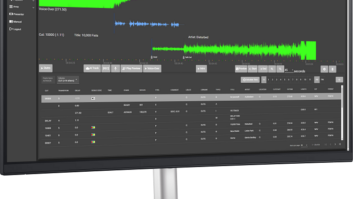If MacGyver were a radio reporter or field engineer, he’d feel right at home with the latest device Joe Klinger and JK Audio introduced at the 2012 NAB Show, the RemoteMix One. It is simply called a field interview tool.

A resourceful field reporter or engineer can solve a lot of problems with it. The RemoteMix One is not only versatile, it’s simple for a reporter on deadline to use. That’s probably the reason Radio World’s judges gave this item a “Cool Stuff” Award.
When I was assigned to write the product evaluation, I had the perfect venue planned for the product evaluation: the Brickyard 400 NASCAR Sprint Cup Race at the Indianapolis Motor Speedway.
The lineup
The RemoteMix One is a wired interface for a dynamic microphone and 1/4-inch stereo headset. It works with both 2.5 mm headset jacks for non-smartphones and 3.5 mm four-conductor jacks for smartphones (iPhone and Android varieties) thanks to two supplied output cords. It takes one 9 volt battery for power,
For this test, I used Audio-Technica’s BPHS-1 broadcast mic and headphone combination.Any standard dynamic microphone and headphone (or earbud) with a 1/4-inch plug can be used. The BPHS-1 headphones lockout background noise effectively and its dynamic boom microphone helps isolate the voice. Both of these came in handy at the Brickyard when cars were on the track.

The wired interface allows the user to use Skype or other smartphone codec apps (e.g., the Comrex ARC Android Reporter Codec for example). Using those codec apps allows voice to pass through the phone with codec fidelity if on a robust 3G/4G cell network or on a Wi-Fi connection.
The Remote Mix One functions as a full-featured telephone headset when not using a smartphone app. If the reporter’s phone is of the standard variety, the 2.5 mm standard cellphone headset jack can still be used, albeit with cellphone voice band audio fidelity. The studio producer will still like the fact that with the RemoteMix One, a wrap can be done in the field in real time, whether it’s live or recorded for future use.
I used my Sprint EVO Shift Android phone and RemoteMix One to connect with CBS’s Comrex Access codec in New York, and used the combination as a regular cellphone headset to verify those capabilities on Sprint’s 3G and 4G networks.
The RemoteMixOne passes better-than-acceptable audio in codec apps and also in the standard mobile phone mode. When monitoring non-mobile audio in the headphones, it sounded as though the user was connected to a studio headphone amp and not a remote device.
Users can mix a 3.5 mm stereo line audio input with the XLR microphone input, which gives real-time wrap capability and allows the reporter or engineer to playback audio from a laptop, netbook or tablet.
Product Capsule
JK Audio RemoteMix One Phone Interface
Plus
+ Small size
+ Good battery life
+ Multiple capabilities
+ Simple controls
+ Rugged construction
Minus
– Reversal of battery door and trim pot access holes
Price: $315
For information, contact Joe Klinger at JK Audio in Illinois at (815) 786-2929 or visit www.jkaudio.com.
The RemoteMix One’s stereo line output is also a mix of microphone on the left channel and the return audio on the right channel. That means the operator or reporter can patch the output into the line input of an audio recorder. (If the recorder has no line input, an attenuating patch cord could be used to lower the audio level to something more mic level friendly.)
Additionally, that output jack provides a field expedient in a situation where audio from a host and caller must go on the air or be recorded or in the case that a classic telephone hybrid is unavailable or won’t connect easily with the equipment that’s available.
The dials are easy to use and have high-contrast white-on-black markings to indicate relative levels. A user could even use the RemoteMix One with a pair of gloves (although the thinner the better) in a cold setting. A clip LED light reminds the reporter or engineer to back down the levels. The power LED functions as a low battery tally light, which will dim and eventually go out before the battery is exhausted. Battery life for the RemoteMix One is rated for 20 hours or better with an alkaline 9 Volt cell. Lithium cells will increase those operating hours at a bit higher cost. No tools are necessary to change batteries.
There’s a momentary mic mute switch for coughs, cussing and other sounds you don’t want going through the microphone channel. It’s also useful if you breathe heavily while you’re playing an actuality during a real time wrap. The headphone channel gives the user enough level to hear even low level cues when at a race track.
The RemoteMix One has an industrial-strength belt clip, which secures the device to a belt, pocket or backpack strap. With a metal case, it’ll survive more of a fall than, perhaps, the telephone to which it is connected.
The only minus (albeit a small minus) might be a rotation of the battery door and trim screws is, in my opinion, 180 degrees off. Not that it would … but when wearing the unit, dust might blow into the small trim pot holes if in a dusty or snowy environment. Reversing the door to face the wind would keep the pots away from the wind.
At a suggested retail price of $315, the RemoteMix One is an investment that can pay for itself in weeks if it’s used for those quick last minute commercial remotes. It’s a cost-effective spend for a news department if amortized over a typical product life cycle. Like all JK Audio products designed for field duty, the physical construction is robust. Unlike audio interface units that are designed to interface with only one style of phone, the RemoteMix One allows for a backup plan. It is reliable, functional and elegant, and a device that any field reporter and engineer would feel confident using when a situation demands mission-critical audio — whether on the phone or through a smartphone codec app.
Paul Kaminski is the news director for the Motor Sports Radio Network, a contributor and free-lance reporter for CBS News, Radio, and since 1997, a Radio World contributor and columnist. His email address is [email protected] ; follow him on Twitter @MSRnet.












